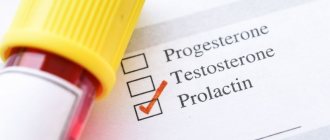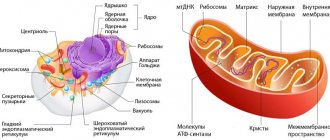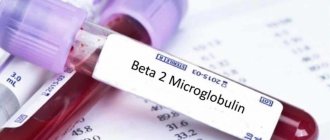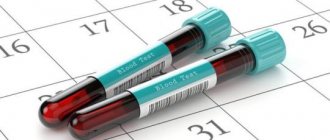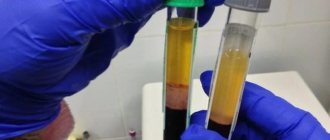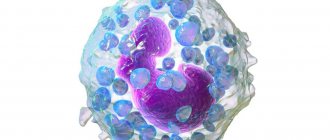General information
SHBG (sex hormone binding globulin) is a glycoprotein - a protein that is synthesized in the liver. By binding to sex hormones, it ensures their free movement in the bloodstream and protection from the destructive effects of enzymes. Analysis for SHBG allows you to evaluate the active fraction of male and female sex hormones (testosterone, estradiol, etc.) and identify pathologies of the reproductive and endocrine systems.
Most SHBG is produced in the liver, with only small amounts produced in the testes, ovaries and brain. After secretion, the globulin enters the bloodstream, where it binds to the hormones of the reproductive system and thyroid gland (estrogen, testosterone, thyroid-stimulating hormones, insulin, etc.). SHBG controls the level of availability of these hormones to cells and tissues, resulting in a healthy hormonal balance in the body.
The concentration of SHBG directly depends on the intensity and volume of sex hormone production. This explains the increased level of glycoprotein in women (estrogen provokes the secretion of SHBG). Male androgenic hormones, including testosterone, on the contrary, suppress the production of SHBG. That is why, with a normal level of globulin in the blood, the concentration of bound testosterone reaches 40-60%, although only 2-3% would be sufficient for body tissues.
If the patient has pathologies of the endocrine system (impaired secretion of thyroid hormones, as well as hormones of the adrenal cortex, pituitary gland, reproductive system), liver or androgen insensitivity syndrome, then the available concentration of SHBG will critically decrease.
Plasma globulin levels depend on several factors:
- intensity of production of hormones of the reproductive system;
- gender and age of the patient;
- the presence of diseases of internal organs and pathologies of endocrine systems;
- body weight, etc.
On a note:
after 60 years, the concentration of SHBG gradually increases (on average by 1.2% annually), and the level of available biologically active sex hormone (estrogen, free testosterone) decreases.
SHBG can also artificially increase after the administration of estradiol in the 3rd trimester of pregnancy. At the same time, the introduction of male hormones provokes a sharp decrease in SHBG levels.
A decrease in SHBG concentration is possible with androgen activity syndrome, hyperprolactinemia (hypersecretion of prolactin), myxedema (acute deficiency of thyroid hormones).
How to increase SHBG in men?
Low glycoprotein in gentlemen leads to weakened muscles, problems with memory, potency, dry skin, and acne. Long-term protein deficiency provokes heart attacks, strokes, and thrombosis. Therefore, if there is a deficiency of the substance, drugs that stabilize the level of male hormones will help. Treatment is carried out under the supervision of an endocrinologist.
If the binding globulin level is low due to internal diseases, it can be normalized only by eliminating the cause. During therapy, you should periodically take tests for SHBG, total and free Testosterone to monitor their ratio. Long-term depression also leads to glycoprotein deficiency, so it is important to stabilize the emotional state. During a steroid cycle, a lack of a specific protein is perceived as normal, but at the end of the cycle, the hormonal levels must be brought into harmony.
Clinical manifestations of impaired SHBG synthesis
- Decreased libido;
- Inability to fertilize in representatives of both sexes;
- Early or late sexual development;
- Gaining fat mass;
- Acne;
- Seborrhea and oily scalp;
- Hair loss, baldness;
- Menstrual irregularities;
- Swelling of the mammary glands in men (gynecomastia);
- The appearance of coarse and dark hair in women above the upper lip, on the back, and also on the legs in the pubic area (hirsutism, male-pattern hair growth).
In addition to analyzing the concentration of glycoprotein in plasma, it is necessary to calculate the free testosterone index. It is defined as the ratio of total hormone to globulin level (data are obtained in %).
How to increase SHBG in women?
In women, a reduced concentration of glycoprotein usually indicates an excess of testosterone. It is manifested by the formation of male secondary sexual characteristics: deepening of the voice, excess body hair, baldness of the head. SHBG deficiency in women can lead to polycystic ovary syndrome, early menopause, problems with conception, and decreased libido. To prescribe adequate treatment and normalize hormonal levels, consultations with an endocrinologist, urologist and gynecologist will be required. It is recommended to take tests for LH, FSH, total and free Testosterone, Estradiol, Prolactin, Insulin, Glucose, TSH, T3 total and free, T4 total and free, AT-TPO, Iodine; DEA-SO4, Cortisol, Progesterone, Aldosterone. Ultrasound of the kidneys, adrenal glands and thyroid...albumin, androgens.
If SHBG is low, antiestrogens (Toremifene, Clomiphene citrate) are usually prescribed. However, you should not take medications on your own: this can negatively affect the functions of the reproductive and other body systems.
Indications for the study
The SHBG level must be determined in the following cases:
- determination of androgen status (for men it is prescribed for a lack of testosterone, and for women, on the contrary, for its excess);
- finding out the true causes of reproductive health disorders (low libido, erectile dysfunction, anorgasmia, infertility);
- assessment of the balance of albumin, insulin, prolactin, estrogen, testosterone, luteinizing hormone, etc.;
- calculation of the free androgen index;
- determining the causes of early or late sexual development;
- determination of markers of insulin resistance (decreased sensitivity to insulin);
- prognosis for the development of gestosis in pregnant women (a severe complication of the 3rd trimester of pregnancy, characterized by disruption of the kidneys, cardiovascular and central nervous systems).
SHBG research is also carried out when diagnosing pathologies:
- polycystic ovary syndrome (their dysfunction due to cycle disorders);
- hirsutism in women (excessive male pattern hair growth);
- alopecia (baldness), oily seborrhea;
- acne (acne disease);
- menstrual irregularities: amenorrhea (absence of menstruation);
- oligomenorrhea (cycle extended over 35 days);
- anovulation (lack of ovulation);
The analysis can be interpreted by an experienced endocrinologist, as well as an andrologist, urologist, gynecologist, pediatrician and other specialists.
ESTRADIOL
In women, estradiol is produced in the ovaries, placenta and zona reticularis of the adrenal cortex under the influence of FSH, LH and prolactin. Estradiol is formed in small quantities during the peripheral conversion of testosterone. In men, estradiol is formed in the testes, in the adrenal cortex, but most of it is formed in peripheral tissues due to the conversion of testosterone. Estradiol ensures in women the formation of the reproductive system according to the female type, the development of female secondary sexual characteristics during puberty, the formation and regulation of menstrual function, the development of the egg, the growth and development of the uterus during pregnancy. It is also responsible for the psychophysiological characteristics of sexual behavior and ensures the formation of subcutaneous fatty tissue according to the female type. A necessary condition for the effects of estradiol to occur is the correct relationship with testosterone levels. Estradiol has an anabolic effect, enhances bone turnover and accelerates the maturation of skeletal bones; promotes sodium and water retention in the body, reduces cholesterol levels and increases blood clotting activity. Daily fluctuations in the concentration of estradiol in the serum are associated with the rhythm of LH (luteinizing hormone) secretion: the maximum occurs between 15 and 18 hours, and the minimum between 24 and 2 hours. In women of childbearing age, the level of estradiol in the blood serum and plasma depends on the phase of the menstrual cycle. cycle. The highest levels of estradiol are observed in the late follicular phase. During pregnancy, the concentration of estradiol in serum and plasma increases at the time of delivery, and after delivery it returns to normal on the 4th day. With age, women experience a decrease in estradiol concentrations. During postmenopause, the concentration of estradiol decreases to the level observed in men. Indications for the purpose of the analysis: diagnosis of disorders of the menstrual cycle and fertility (ability to produce offspring) of women, amenorrhea, oligomenorrhea, anovulation, hypogonadism, disorders of puberty, osteoporosis (in women), hirsutism, infertility, premenstrual syndrome, signs of feminization in men. An increase in estradiol levels is observed with hyperestrogenism; endometrioid ovarian cysts; tumors of the ovaries, testicles, liver cirrhosis, pregnancy, taking hormonal drugs. Estradiol levels are reduced during intense physical activity in untrained women, with significant weight loss, a high-carbohydrate, low-fat diet, in vegetarians, and in early pregnant women who smoke; for chronic inflammation of the internal genital organs, chronic prostatitis, insufficiency of the gonads and other conditions. Preparation for the study: on the eve of the study, avoid physical activity (sports training) and smoking. In women, the analysis is performed on days 6-7 of the menstrual cycle, unless other dates are indicated by the attending physician.
Reference values
| Patient age | Women, nmol/l | Men, nmol/l |
| 0 – 2 years | > 64 | < 97 |
| 24 years | 33 – 135 | 27 – 110 |
| 4 – 6 years | 23 – 100 | 37 – 148 |
| 6 – 8 years | 30 – 121 | 20 – 114 |
| 8 – 10 years | 26 – 128 | 38 – 132 |
| 10 – 12 years | 16 – 112 | 21 – 150 |
| 12 – 14 years old | 19 – 89 | 13 – 102 |
| 14 – 60 years | 18 – 114 | 13 – 71 |
| 60 – 70 years | 17 – 140 | 15 – 61 |
| > 70 years | 39 – 154 | 15 – 85 |
At the same time, the calculated free testosterone index (FTI) in the blood is determined. The following standard indicators have been established for IST:
| Patient's gender and age | IST, % |
| Women from 14 to 50 years old | 0,8 – 11 |
| Men from 14 to 50 years old | 14,8 – 95 |
PROGESTERONE
Progesterone is a female sex hormone produced in the corpus luteum of the ovaries and adrenal glands. Outside of pregnancy, progesterone secretion begins to increase in the preovulatory period, reaching a maximum in the middle of the luteal phase, returning to its original level at the end of the cycle. The content of progesterone in the blood of a pregnant woman increases, doubling by 7-8 weeks, and then gradually increasing until 37-38 weeks. After ovulation - the release of an egg from the follicle - a corpus luteum is formed in its place in the ovary - a gland that secretes progesterone. It exists and secretes this hormone during 12-16 weeks of pregnancy until the moment when the placenta is fully formed and takes over the function of hormone synthesis. If conception does not occur, the corpus luteum dies after 12-14 days, and menstruation begins. Progesterone is determined to assess ovulation and the viability of the corpus luteum. With a regular cycle - a week before menstruation, when measuring rectal temperature - on the 5-7th day of its rise; with an irregular cycle - several times. A sign of ovulation and the formation of a full-fledged corpus luteum is a tenfold increase in progesterone levels. Indications for the analysis : identifying the causes of menstrual irregularities, infertility, dysfunctional uterine bleeding, assessing the condition of the placenta in the second half of pregnancy, differential diagnosis of true post-term pregnancy. An increase in progesterone levels is observed with adrenal hyperplasia, corpus luteum cyst, pregnancy, and delayed maturation of the placenta. The analysis will show a decrease in progesterone levels in the absence of ovulation, insufficiency of the corpus luteum, true postmaturity, placental insufficiency, intrauterine growth restriction, or threatened abortion. Preparation for the study: the analysis is carried out on the 22-23rd day of the menstrual cycle, unless other dates are indicated by the attending physician. Blood is taken in the morning on an empty stomach, that is, when 8-12 hours pass between the last meal and blood collection. You can drink water.
Lowering values
- Nephrotic syndrome (kidney damage that leads to generalized edema);
- Increased secretion of androgenic hormones;
- Hypothyroidism (underfunction of the thyroid gland);
- Hirsutism;
- Cushing's disease (increased production of adrenal hormones);
- Resistance to the hormone insulin;
- Liver damage (cirrhosis);
- Collagenosis (changes in the structure of connective tissue);
- High concentration of prolactin;
- Adrenogenital syndrome (impaired production of hormones by the adrenal cortex);
- Acromegaly (dysfunction of the anterior pituitary gland);
- Polycystic ovary syndrome;
- Taking medications: androgenic hormones, steroids, glucocorticoids, danazol, somatostatin.
On a note:
When interpreting the test, it is necessary to take into account that in children the level of SHBG may be normally elevated. In older men, globulin concentration also increases. But in women during menopause, on the contrary, it gradually decreases, which is associated with a decrease in ovarian function.
PROLACTIN
Prolactin is a hormone produced in the anterior pituitary gland; a small amount is synthesized in peripheral tissues, and during pregnancy it is also produced in the endometrium. This hormone plays an extremely important role in many processes occurring in the body, in particular, in ensuring the normal functioning of the reproductive system. Prolactin also contributes to the formation of sexual behavior. It regulates water-salt metabolism, delaying the excretion of water and sodium by the kidneys, stimulates calcium absorption, and has a modulating effect on the immune system. In general, prolactin activates anabolic processes in the body. The daily secretion of prolactin has a pulsating character. During sleep, its level increases. After waking up, the concentration of prolactin decreases sharply, reaching a minimum in the late morning hours. After noon, the hormone level increases. In the absence of stress, daily fluctuations in levels are within normal values. During the menstrual cycle, prolactin levels are higher in the luteal phase than in the follicular phase. From the 8th week of pregnancy, prolactin levels increase, reaching a peak at 20-25 weeks, then decrease immediately before childbirth and increase again during lactation. During pregnancy, prolactin supports the existence of the corpus luteum and the production of progesterone, stimulates the growth and development of the mammary glands and milk formation. An increase in prolactin levels is one of the common causes of infertility. Indications for the analysis: galactorrhea, cyclical pain in the mammary gland, mastopathy, anovulation, oligomenorrhea, amenorrhea, dysfunctional uterine bleeding, infertility, diagnosis of sexual infantilism, chronic inflammation of the internal genital organs, severe menopause, obesity, decreased libido and potency (men) , gynecomastia (men), osteoporosis. The analysis shows an increase in prolactin levels in diseases of the hypothalamus, pituitary gland, primary hypothyroidism, polycystic ovary syndrome, chronic renal failure, cirrhosis of the liver, adrenal insufficiency and congenital dysfunction of the adrenal cortex; tumors that produce estrogen and other conditions. The level of prolactin in the blood is usually reduced in case of pituitary insufficiency, true post-term pregnancy. Preparation for the study: Avoid sexual intercourse and heat exposure (sauna) 1 day before, smoking 1 hour before. Since prolactin levels are greatly influenced by stressful situations, it is advisable to exclude factors that influence the research results: physical stress (running, climbing stairs), emotional arousal. Therefore, before the procedure you should rest for 10-15 minutes and calm down.
Cortisol (Hydrocortisone)
Steroid hormone of the adrenal cortex; the most active of the glucocorticoid hormones.
Regulator of carbohydrate, protein and fat metabolism. Cortisol is produced by the zona fasciculata of the adrenal cortex under the control of ACTH. In the blood, 75% of cortisol is bound to corticosteroid binding globulin (transcortin), which is synthesized by the liver. Another 10% is weakly bound to albumin. Cortisol is metabolized in the liver, the half-life of the hormone is 80-110 minutes, it is filtered in the glomeruli and eliminated in the urine.
This hormone plays a key role in the body's defense response to stress. It has a catabolic effect. Increases the concentration of glucose in the blood by increasing its synthesis and reducing utilization in the periphery (insulin antagonist). Reduces the formation and increases the breakdown of fats, promoting hyperlipidemia and hypercholesterolemia. Cortisol has little mineralocorticoid activity, but when it is formed in excess, sodium retention in the body, edema and hypokalemia are observed; a negative calcium balance is formed. Cortisol potentiates the vasoconstrictor effect of other hormones and increases diuresis. Cortisol has an anti-inflammatory effect and reduces the body's hypersensitivity to various agents, suppressing cellular and humoral immunity. Cortisol stabilizes lysosome membranes. Helps reduce the number of zosinophils and lymphocytes in the blood while simultaneously increasing neutrophils, erythrocytes and platelets.
The daily rhythm of secretion is characteristic: maximum in the morning (6-8 hours), minimum in the evening (20-21 hours). Cortisol secretion changes little with age. During pregnancy, a progressive increase in concentration is observed, associated with an increase in the content of transcortin: in late pregnancy, a 2-5-fold increase is noted. The daily rhythm of release of this hormone may be disrupted. In the case of a partial or complete block in the synthesis of cortisol, an increase in the concentration of ACTH and the total concentration of corticoids occurs.
Limits of determination:
27.6 nmol/l-6599.6 nmol/l.
Complexes with this research
Advanced male anti-aging diagnostics Advanced monitoring of key indicators in men aged 40+ 33,710 R Composition
Male hormones Assessment of hormonal levels in men at any age 6,180 R Composition
Male infertility. Extended examination Analysis of male reproductive health 29,030 RUR Composition
IN OTHER COMPLEXES
- Female hormones. Follicular phase 5,930 R
- Male anti-aging diagnostics RUB 13,300
- Anti-aging diagnostics. Hormonal balance RUB 6,250
DEA-SO4 (Dehydroepiandrosterone sulfate)
DEA-SO4 is produced in the adrenal cortex. Its level is an adequate indicator of androgen-synthetic activity of the adrenal glands. The hormone has only a weak androgenic effect, but during its metabolism testosterone and dihydrotestosterone are formed in peripheral tissues. During pregnancy, DHEA-SO4 is produced by the adrenal cortex of the mother and fetus and serves as a precursor for the synthesis of placental estrogens. By puberty, the level of this hormone increases, and then gradually decreases as a person reaches reproductive age. The level of DHEA-SO4 also decreases during pregnancy. Indications for the analysis: adrenogenital syndrome, tumors of the adrenal cortex, ectopic ACTH-producing tumors, recurrent miscarriage, fetal hypotrophy, diagnosis of the state of the feto-placental complex from 12-15 weeks of pregnancy. Increased levels of DHEA-SO4 are observed in adrenogenital syndrome; tumors of the adrenal cortex; ectopic ACTH-producing tumors; Cushing's disease; feto-placental insufficiency; hirsutism in women; threat of intrauterine fetal death. The level of DHEA-SO4 is reduced in case of fetal adrenal hypoplasia (concentration in the blood of a pregnant woman); intrauterine infection; when taking gestagens.
